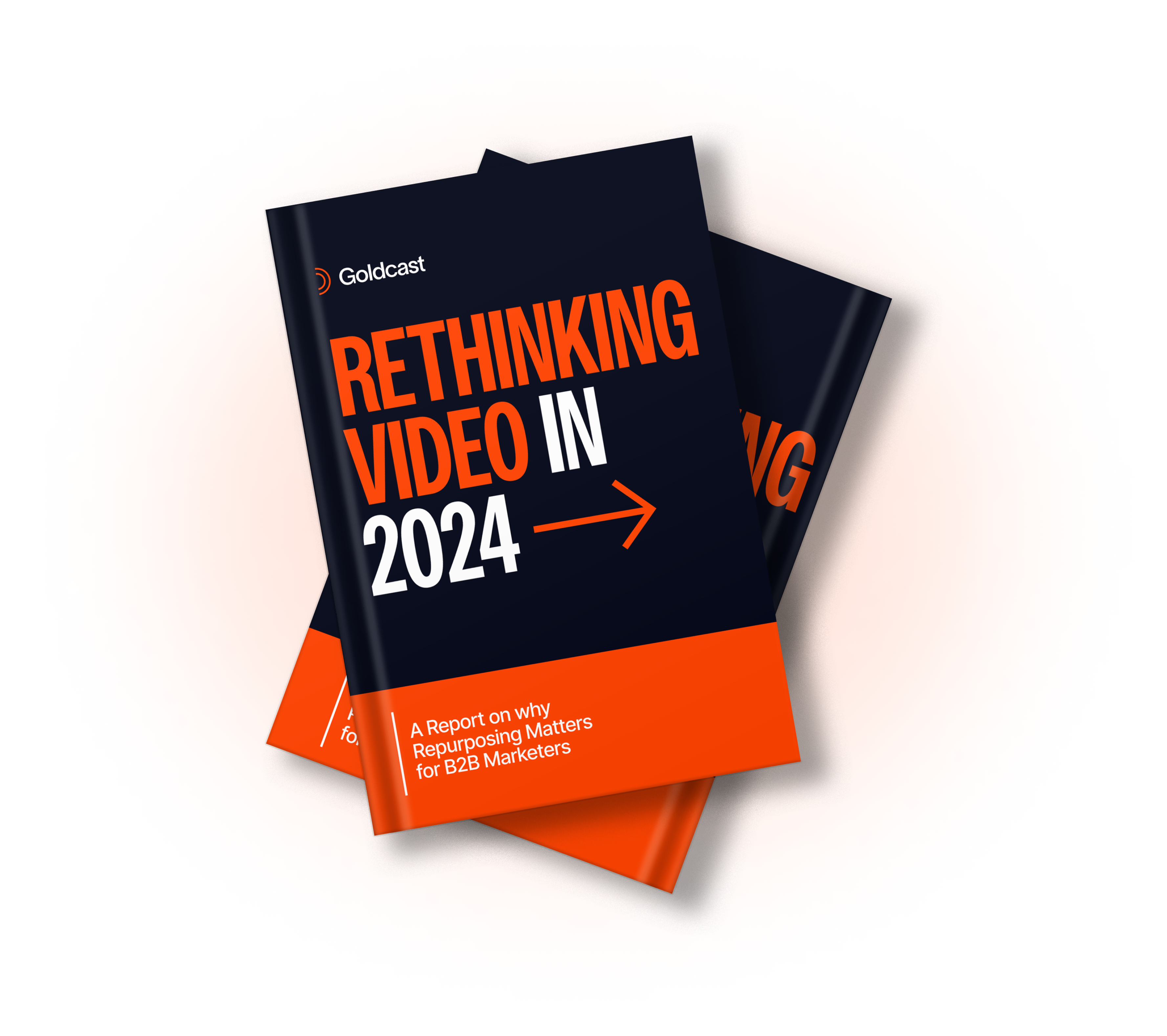Rethinking Video in 2024: A Report on Why Repurposing Matters for B2B Marketers
In an era where content is king, our aim is to provide B2B marketers with the tools and knowledge needed to maximize the value of their video content.
Interested in transforming your B2B event videos into many different types of content?
Perhaps you've been looking to get started with video repurposing, but you're not sure how you'll make it work with a time- or budget-strapped team—all too familiar territory for most marketers right now.
We've got good news for you: With AI-powered platforms, you can say goodbye to the days when you had to spend weeks working on a video just to get one clip ready to go. With Content Lab, you simply upload your video—whether it's a webinar, panel discussion, interview, or something else—and watch as it turns into blogs, social media posts, video clips, and more.
Using AI tools to speed along video repurposing is quickly becoming an industry standard. In Wistia's State of Video in 2024 report, 85% of marketers stated that generative AI has changed content creation. Most marketers believe that from 2024 on, most content will be built, at least in some way, by generative AI.
In this guide, you'll see how video repurposing is the best way to turn existing content into valuable assets you can share across all of your platforms, ensuring that your message finds new audiences and reaches people where they hang out. You'll discover specific tips for posting on each platform. And, you'll see how AI tools help make all of this possible.
Our hope is to provide B2B marketers like you with the video content tools and understanding that you need to successfully compete in today's changing digital marketing landscape.
Specifically, we'll discuss:
- Audiences love videos—so what keeps marketers from creating them?
- The historical challenge with video
- As the landscape shifts, so should your content strategy
- Video repurposing: The new content marketing strategy
- Best practices for repurposing content
- Quick reference: How to post video on each social media platform
- Get ready for your next event: Printable video repurposing checklist
- Find the right tool to repurpose your content
- Goldcast Content Lab: Let AI do the heavy lifting
- The importance of strong AI prompts
- Best practices for prompting Goldcast Content Lab
- Unleash the repurposing power of AI
We've got a lot to cover. Let's get started!
Audiences love videos—so what keeps marketers from creating them?
Video repurposing, or turning videos into different types of content to be shared, has become a key component of modern B2B marketing.
In today's video-first world, the way people consume content has changed. Video-hosting platforms like Wistia have seen video plays and total watch time soar exponentially each year and—even with all the talk about shortened attention spans—longer videos see higher conversion rates.
Audiences love videos. They want content to be easily accessible, available on demand, and highly digestible—and videos check off every box on that wish list. That means that bingeable content, as well as quick bite-sized videos, are a sure bet to spread your message and build your brand.
So, what keeps everyone from getting into video? According to the State of Video report, 61% of companies cite time and bandwidth as major challenges, and 44% of orgs say that their team size, resources, and technical abilities impede their ability to create videos.
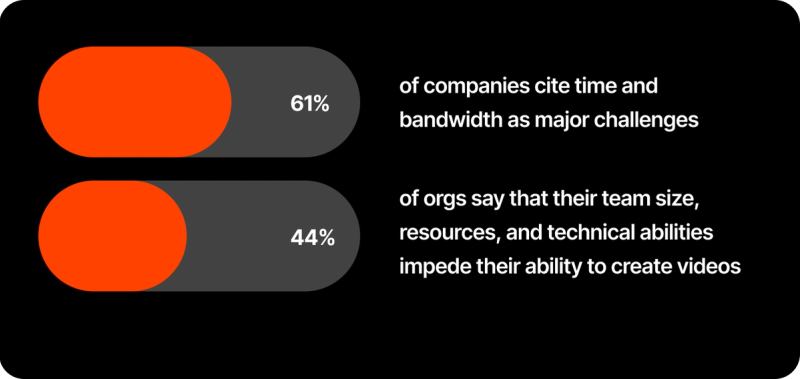
Relatable, right? There have historically been lots of roadblocks standing in between marketers and video content, and that's only recently started to change.
The historical challenge with video
Video has always been popular. The first documentation of moving pictures being shown to an audience happened in Paris way back in 1895, and the rest is history. People love the immersive nature of watching something as opposed to reading it or hearing about it; videos just hit different.
Once the Internet came about, it was only a matter of time before things became video-focused. Even years ago, in 2017, Cisco predicted that video traffic would represent 82% of all consumer Internet traffic by 2022.
Despite its widespread, undeniable appeal, B2B marketers didn't dive right into video creation. There were many reasons for this. Video production was involved; you needed a certain level of expertise to create quality videos. Most B2B marketing teams didn't have dedicated video production folks, and they didn't have the budget to hire out for that.
Video production was also complicated and expensive. In addition to the expert videographers, editors, and other staff members, you needed specialized software and high-quality equipment if you wanted your videos to turn out well. That's not even mentioning the editing and post-production phases, once you had your raw footage. There were many phases of the video planning process to consider, all of which felt overwhelming if you weren't familiar with it.
The challenges didn't stop there. For a while, it was hard to measure the ROI on video content. It wasn't as straightforward as a blog post, where you can clearly outline how much traffic the blog generated, who clicked on what, and so on. Tools have since sprung up that do measure video ROI but in the beginning, this was another quagmire.
Video also felt lacking when it comes to personalization, which marketers know that audiences want. Given all of the investment required to make just one video, how could we even think about turning that video into multiple other videos to speak to different customer personas?
Today, the landscape is almost unrecognizable. B2B companies are catching up to B2B playbooks and learning that audiences love humanized, accessible, relatable content—and, as a result, more B2B videos are being made than ever.
AI in particular has revolutionized the way that marketers approach video creation, making it cost-effective, efficient, and a no-brainer component of any marketing strategy.
As the landscape shifts, so should your content strategy
The content playbook that B2B marketers have been running for the last decade or so is outdated now. People are used to platforms like Spotify and Netflix giving them content on the go in easy-to-consume formats, and they're not going to accept anything less.
All signs point to video as a necessary part of a modern, successful B2B marketing strategy, and the message is clear: If you want to compete in today's landscape, you'll have to get comfortable with video.
Still not convinced? Let's dive into some other trends:
Shrinking attention spans
With so much info and stimuli out there, people's attention spans have become shorter. According to one study, in 2004, the average attention span was 2.5 minutes but today, people can only pay attention for an average of 47 seconds.
What this means for you: Quick, engaging content is the way to hook people's attention and stand out from the pack. Video content is immersive and is a proven way to grab folks' interest.
Generational shifts
As the younger generations gain more buying power, this has an impact on marketing trends. Gen Z and their younger counterparts have grown up with video everywhere. In fact, Gen Z are more likely to watch videos every day than the general adult population.
What this means for you: If you want to remain relevant and attract younger crowds, video is the way to go.
Influence of B2C on B2B marketing
The line between B2C and B2B, though it was historically a distinct one, is becoming increasingly blurred as B2B marketers realize that their audiences want the same type of personalized, engaging experience they get with B2C companies.
What this means for you: Start studying B2C companies like Airbnb and Warby Parker. Poke through their social media sites and websites; we bet you'll see video content woven throughout!
Emergence of new content platforms
TikTok has over 5.3 billion internet users and has proven that people respond well to short videos, whether they're irreverent or educational. We've also seen platforms like Instagram Reels and YouTube soar in popularity over recent years.
What this means for you: Again, you want to meet your audience where they're already hanging out, which means releasing videos on these platforms is a good strategy.
Changes in search and data landscape
With increasing emphasis on user privacy and the deprecation of third-party cookies, companies have to find new ways to reach audiences. Google's SGE (Search Generative Experience) will also require companies to create unique, authoritative, diversified content in order to rank.
What this means for you: If you're already focusing on certain types of content, like blogs or infographics, your search rankings will benefit from changing things up and adding video content to the mix.
AI and other tech advancements
Finally, we can't talk about video and video repurposing without talking about another major trend: technological advancements. With the help of AI, tools like Content Lab automate and streamline video production processes, empowering B2B marketers to create high-quality, timely video content in just minutes.
The emergence of AI has been a game-changer, effectively democratizing the video production and repurposing process so that any marketer can take advantage of the benefits. With AI, there's no reason that repurposing can't be a part of your marketing strategy.
It's clear that what worked for businesses in the past just won't cut it today. Lucky for you, there are already a number of businesses leading the way when it comes to video repurposing with AI. Read on to learn how to join their ranks!
Video repurposing: The new content marketing strategy
You may now be able to see more of a full picture of how we arrived here, in our video-first marketing world. This is a great time to get started or dive deeper with video repurposing because there are less barriers than ever.
First: a refresher on the basics of video repurposing!
What is video repurposing?
Video repurposing is taking an existing video and then turning it into different types of content to maximize its reach and value across different platforms and channels. This is a strategic approach to take, seeing as you've typically spent a considerable amount of resources developing the content you're repurposing—in our line of business, that's usually events.
By taking something like an event recording and breaking it into various other formats and then sharing it on other channels, you move your content strategy into the modern era and show your audience that you understand them. All this while working smarter, not harder!
The benefits of video repurposing
We'll start by saying we're well aware of the budget and cost constraints many marketing teams are faced with. We're navigating uncertain times; there's no doubt about it. Many marketers have experienced one or more layoffs in recent years, and the economy still feels a bit wobbly.
Thus, it might seem daunting to learn something new when you've already got so much on your plate. However, we promise that we wouldn't be pushing video repurposing if we didn't think it was a way to make your life easier and actually lighten your workload in the end.
That said, here are some of the major benefits of video repurposing:
- Multi-channel distribution: Audiences want to be met where they're already at, and repurposing allows you to do that. When you take a video and turn it into a short clip and share it on Instagram, Twitter, LinkedIn, and other channels, you're catering to different preferences and boosting your brand signal.
- It's cost-effective: You've already put in the work to host your event and create the original video, which is no small feat. Why not continue getting as much value from that initial investment as you can and stretch your content budget as far as it can go?
- Extended content lifecycle: When your videos live on through other formats, or even in an on-demand evergreen library, you keep them relevant for longer than they would be if you did nothing after your event ended.
- Consistent pipeline: We've talked to customers who were still using repurposed content from a January event four months later—with no plans to stop anytime soon. Repurposed content floods your pipeline in a good way and provides you with a steady stream of fresh things to post!
- Enhanced SEO value: You can take your video and transform it into other assets that give you an SEO boost, like blogs, infographics, YouTube videos, and more. This helps new people discover you as they're searching for relevant content.
- Brand-bolstering: As you present the same message again and again, across different channels, you're subtly reinforcing your brand messaging and increasing the likelihood that you'll be top of mind when your audience is ready to make a buying decision.
- Opportunities to A/B test: While you're mixing up your content, why not use it as a chance to see what sticks with your audience? By A/B testing different content, you can get valuable insights on whether folks prefer short- or long-form video, what messaging works best, and more.
When it comes to event videos, repurposing is especially valuable because events often naturally lead to shareable moments. For example, if you host an in-person event and people are hyped about attending, sharing some clips of people's energy at the event can help attract new registrants next time and let people know what your company culture is all about.
On the other hand, say you've got a product demo video. You'd probably be able to easily turn that into videos offering quick expert tips, helpful product info, or even how-to articles or infographics you can distribute to new or existing customers.
Ultimately, no matter what type of video you have, repurposing it helps you get the most bang for your buck.
If you're curious about specifics about what types of videos you should repurpose, as well as how to repurpose for different platforms, buckle up. That's where we're headed next!
Ideal videos for B2B repurposing
Which videos are the best to repurpose?
Well, this is kind of a trick question because all videos are ideal videos to repurpose. You can typically find golden nuggets within every single video.
That said, there are a handful of videos that get you the most runway:
Panel discussions
Panels usually result in a goldmine of expert insights, takeaways, and pull quotes. You can create focused thought leadership pieces from panel discussions, as well as short-form video clips to share on social media. You might even use some of the topics covered to spin off into other, new topics for podcasts and other platforms.
Product demos
These events showcase a product's features and benefits, and the video can be sliced up to create quick educational tips or how-tos you can share with your audience. You might also use a string of videos to create an FAQ series answering folks' most-asked questions or a "step-by-step" series breaking down how to do something.
Customer interviews
Interviews like the one we did with LG Electronics humanize your brand and help your audience understand how your product or service might work for them.
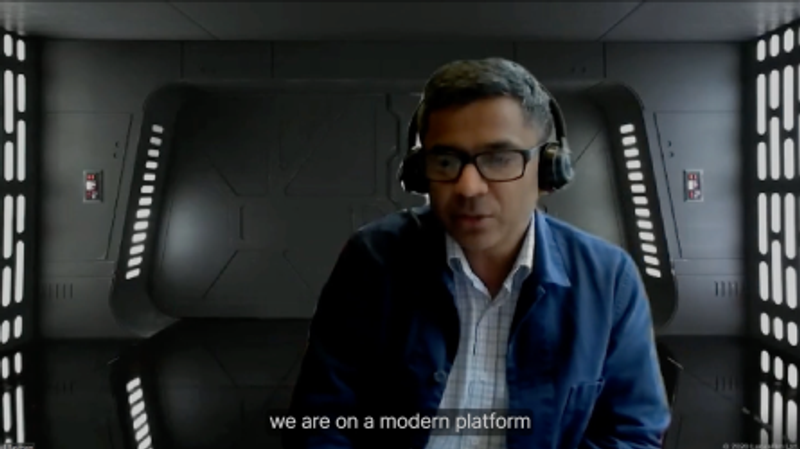
Once you have your full interview video, you can repurpose it into powerful testimonials, helpful case studies, and weave the clips into blog posts, like we do with all of our customer stories. Sharing stories about how your product solved a customer challenge will definitely resonate with your target audience!
Webinars
Traditional webinars are still good options for video repurposing. Look for key insights, tips, and best practices from the webinar, as well as times when conversation or engagement shot up during the event—that's always a sure sign that people want to hear or talk more about a certain topic!
As an example, one of our customers, Qualio, hosted a popular webinar in January 2024. Using Goldcast's Content Lab, the team was able to turn hours of content into super on-point, niche clips that they could share with their audience and use to fuel their organic social plan. Check it out:
Keynote speeches
Because an expert or influencer is the one who usually gives a keynote speech, these can turn into great authority-building or thought leadership video content. You want to find the most inspiring quotes, key messages, strongest stories, and maybe even a cliffhanger or two to hook people's interest.
Conferences and multi-day events
Remember what we said about webinars giving you good videos to repurpose? Conferences and multi-day events do that too, but with exponentially more key moments. And remember: If going through days and days of video footage sounds daunting, experiment with a tool like Content Lab to simplify your process.
Best practices for repurposing content
Before we discuss different social media platforms and what type of videos you should create for each one, let's get some general dos and don'ts out of the way.
✅ Do prioritize evergreen content. Video content that is timeless and will remain relevant over a longer period is probably the best type to focus on—although there could be value in being quick to post some of the more viral, timely snippets right away.
However, outside of those rare viral instances, videos containing info that could be shared across a variety of settings and contexts, or for different marketing purposes, are the ones that make sense to repurpose.
❌ Don't forget to give credit where it's due. If you're adding any type of music, external video clips, or third-party images to your content, be sure that you check that you're legally able to share that content and find out if you need to give credit to the original source.
✅ Do optimize your repurposed content for specific platforms and audience. Don't just repost the same content across every channel (a surefire way to get people to unfollow your brand). Ideally, you've saved time with repurposing tools and now you can reinvest some of that time into tailoring your repurposed content for each platform and its respective audience.
❌ Don't skimp on quality. Sure, we want all marketers to get involved in video repurposing, but not at the expense of quality. We know that it's 100% possible to create high-quality videos, no matter your experience level, so be sure that you leverage the right tools if you need help (more on that soon).
✅ Do use AI to identify key moments in videos. We keep driving this point home because it's an important one—saving time while still doing a quality job is what it's all about, and AI makes that possible. With AI, you can zero right in on those key moments and most impactful quotes, and repurposing becomes an efficient and—dare we say?—fun process.
✅ Do keep your brand tone and image consistent. Even though you're creating repurposed snippets, check to make sure that your brand image and identity is consistent throughout the new assets. This helps reinforce your brand experience and boost brand recognition.
❌ Don’t forget to align repurposed content with your overall marketing goals. Video for video's sake is never the goal, so be sure to verify what your overall goals are.
For example, if you're looking to build brand awareness, your repurposed content should focus on doing that, whether it's by spreading the word about your company culture or establishing your CEO as a thought leader in the space.
✅ Do track and analyze performance. The same way that you measure ROI on your other marketing assets (or at least we hope you do!), you should assess how your repurposed content is doing over time. This will help you hone in on what's resonating with folks and what's not so you can get better as you go!
Quick reference: How to post video on each social media platform
Below, we'll tell you what type of content to focus on for each social media platform, as well as the right format and length to go with.
- Focus: Professional insights, industry news, thought leadership
- Format: Preferably square (1:1) or horizontal (16:9) for feed compatibility
- Length: Keep clips under 2 minutes for maximum engagement
- Editing Tips: Use captions for silent autoplay, include branded intros/outros for consistency, and ensure clear, concise messaging
TikTok
- Focus: Educational content with an emphasis on being authentic and relatable
- Format: Vertical (9:16) to utilize the full screen on mobile devices
- Length: Aim for 15-30 seconds to match platform norms
- Editing Tips: Leverage quick cuts, add popular music, and use text overlays to enhance viewer understanding without sound
- Focus: Interactive, community-driven content that builds credibility and relationships
- Format: Square (1:1) for better mobile viewing or horizontal (16:9) for shared links
- Length: Optimal at 1 minute to encourage sharing and comments
- Editing Tips: Include eye-catching thumbnails, use captions for silent viewers, and tailor the first 3-5 seconds to grab attention right away
- Focus: Visually compelling content showcasing products, services, or brand culture
- Format: Vertical (9:16) for Stories and Reels, square (1:1) for the feed
- Length: 15-30 seconds for Reels to keep user interest
- Editing Tips: Use high-quality visuals, engage with stickers and interactive features in Stories, and ensure your branding is visible
YouTube
- Focus: Educational content, product showcases, and brand storytelling
- Format: Horizontal (16:9) for traditional videos, vertical (9:16) for Shorts
- Length: Under 60 seconds for Shorts to quickly capture the essence of your message
- Editing Tips: Focus on high-quality audio and visuals, use engaging hooks in the first few seconds, and include a call to action
Video editing best practices across platforms
No matter which platform you're posting to, these tips apply across the board:
- Include captions to boost accessibility and accommodate people who watch videos without the sound on.
- Be sure that your branding is consistent. This includes elements like your logo, the colors you use throughout your video, and the intros/outros you include. You don't want to confuse viewers by posting something totally off-brand!
- Be clear with engagement cues. Including a question or a call to action can encourage viewer interaction, which can also boost the visibility of your post.
- Optimize the video thumbnail. People are more likely to click on something that grabs their interest right away, so even though the thumbnail seems like a (literal) tiny detail, it's worth spending time on.
Now that you know what types of video content you should use for each platform, you're almost ready to go. Don't forget that an AI tool like Content Lab can help you take a single video and turn it into snippets that meet all of the above requirements, in just a few minutes!
Get ready for your next event: Printable video repurposing checklist
If you're a check-the-boxes kinda marketer, we're right there with you! This comprehensive video repurposing checklist will walk you through the entire repurposing process, from pre-event prep to post-event follow-up, ensuring that no content goes to waste along the way.
You can even print it out and keep it on hand for future events!
Pre-Event Preparation:
- Select target content: Identify key sessions, panels, or presentations with the highest potential for repurposing.
- Map out repurposing strategy: Determine the types of assets you'll create post-event (e.g., blog posts, social clips, infographics).
- Set up Goldcast Content Lab: Ensure your account is ready, with teams invited and brand kits activated.
Immediately Post-Event:
- Upload recordings: Securely upload your completed event recordings to Goldcast Content Lab.
- AI Transcription: In just a few minutes, Goldcast Content Lab automatically transcribes your event recordings, providing a versatile base for various content formats.
- Highlight key moments: AI will also identify and mark segments within your recordings for easy access and repurposing. You can review and keep the ones that resonate!
Repurposed Content To Create:
You may not create every asset below, but you can use this as a reminder of the potential types of repurposed content!
- Social media clips: Leverage AI to create engaging video clips for platforms like LinkedIn, Twitter, TikTok, and Facebook. Customize clips using preset templates or create your own with Goldcast Content Lab’s editor.
- Blog posts: Transform panel discussions or keynote sessions into informative blog series or individual articles, enhancing your SEO and offering in-depth insights to your audience.
- E-books or guides: Segment and chapterize transcripts from keynote speaker talks or workshops to compile comprehensive e-books or industry guides, providing valuable resources to your target audience.
- Educational audiograms: Extract audio snippets from leadership talks or Q&A sessions to craft motivational or instructional audiograms for auditory learners.
- Email content: Use AI-generated summaries and key takeaways from various sessions to feed follow-up messaging and email newsletters, keeping your audience engaged and informed.
How To Use Repurposed Content for Engagement and Lead Generation:
Again, you may not use all of these, but it's a good idea to get as much runway as you can.
- Optimize for SEO: Ensure all repurposed content is SEO-friendly, incorporating relevant keywords and metadata to improve visibility and organic reach.
- Share on social media: Distribute your newly created content across social platforms, using relevant messaging for each to maximize engagement and reach. (Don't forget to optimize content for each platform!)
- Incorporate into email campaigns: Enhance your lead nurturing efforts by including repurposed content in your email marketing campaigns.
- Monitor and analyze performance: You can't improve if you don't know how your content performed! Goldcast Content Lab’s analytics tools track the performance of repurposed content, gaining insights into engagement, reach, and lead generation.
By following this checklist and relying on the powerful capabilities of Goldcast Content Lab, your event content will turn into a ton of marketing assets that continue to provide value long after your event is over. We can't wait for you to start creating and sharing today and see how Content Lab can transform your marketing efforts!
Find the right tool to repurpose your content
When you're ready to efficiently rev up your repurposing capacity, it's time to choose the right tool!
A good repurposing tool can save you money, as it eliminates the resource-intensive way of doing things. You won't have to outsource your video repurposing needs, and you won't need to invest in specialized equipment to pull off a quality video.
The right tool can create high-quality, engaging content that captures your audience's attention, time after time. With the addition of AI, the likelihood of manual error all but disappears, leaving you with consistent, polished clips you can post across platforms.
Finally, when you work with a great tool, you save time—something we all need more of! Manually repurposing content can take what feels like eons, as you sift through hours of content to identify the critical, unmissable moments, and that's time you can't spend on other tasks.
Goldcast Content Lab shines because it does all of the above. You save money and time, and you're able to quickly move through the repurposing checklist, get your video clips ready to distribute, and move on to other tasks.
Goldcast Content Lab: Let AI do the heavy lifting
With its cutting-edge, AI-powered video repurposing capabilities, Content Lab offers B2B marketers everything they need to repurpose event recordings. Whether it's an instant transcript you can pull text from or repurpose into a blog post or the fact that you can customize repurposed content to match your brand identity, we've thought of everything.
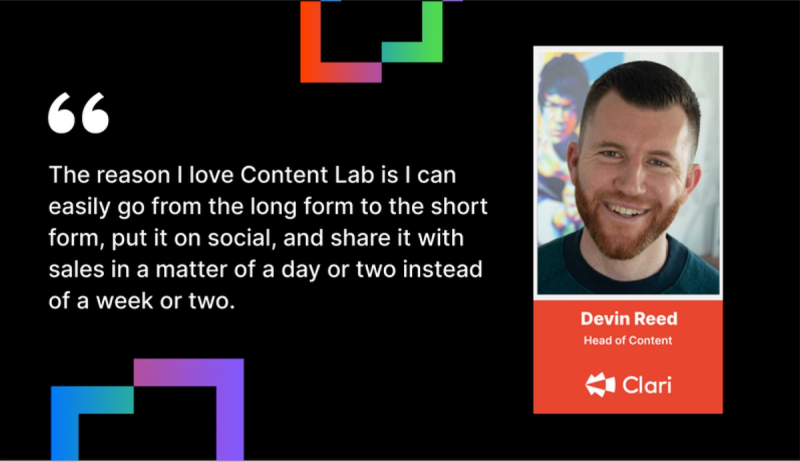
Here's just a handful of the things Content Lab can do for you:
- Create SEO-optimized blog posts, based on your event
- Whip up a social post that you can use during your event to promote it, like ActiveCampaign did during its 29 hours of marathon programming
- Draft compelling follow-up emails that boost on-demand views
- Compile promo kits you can provide to speakers to amplify your post-event reach
- Produce subtitled audiograms you can share on social media
- Put together highlight reels from other past events that attract folks to register for an upcoming event
Companies like Mailchimp, Uber, and 6sense trust Content Lab to take an upload and, within minutes, spin up tons of marketing assets that can be put to use for months—or even years—afterward.
With Content Lab, all the heavy lifting is done by AI. Seriously. All of it! The only job you have here is to open up your imagination and dream up the big ways you can put your new content to use.
For our visual learners, here's a step-by-step walkthrough of how we used Content Lab to repurpose content from one of our events:
Devin Reed, Head of Content at Clari, uses Content Lab to fuel what he calls a "content waterfall." With Content Lab, he's able to quickly remove filler words, throw CTAs on his clips, and essentially build a high-quality content assembly line that never stops moving.
Check out the way Devin explains the benefit of Content Lab:
There's no doubt about it: Goldcast Content Lab empowers your team to maximize the value of your video content, while simultaneously reducing the time and financial investment you spend to get there.
If you want to see what Content Lab can do with your existing content, give it a whirl for 14 days—on us!
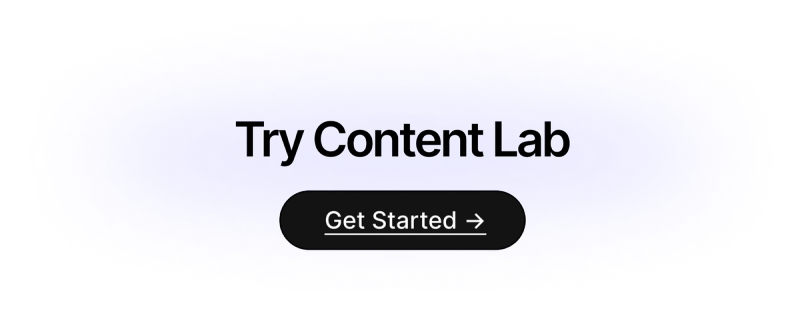
The importance of strong AI prompts
When it comes to executing your content repurposing strategy with Goldcast Content Lab, AI prompting plays a crucial role. AI is capable, but it can only operate based on what you tell it to do. A well-crafted prompt significantly boosts the quality and relevance of the tool's output.
Strong AI prompts help the AI to understand exactly what you want, upping the chances that the final product matches what you wanted going in. AI is also evolving to "remember" preferences, which means that the more you teach it, the better your content will be.
How then do you craft a clear AI prompt? Below is a table showcasing various use cases for AI prompting within Goldcast Content Lab. Take a look through the examples and start to think about how you might develop prompts for your own use cases.
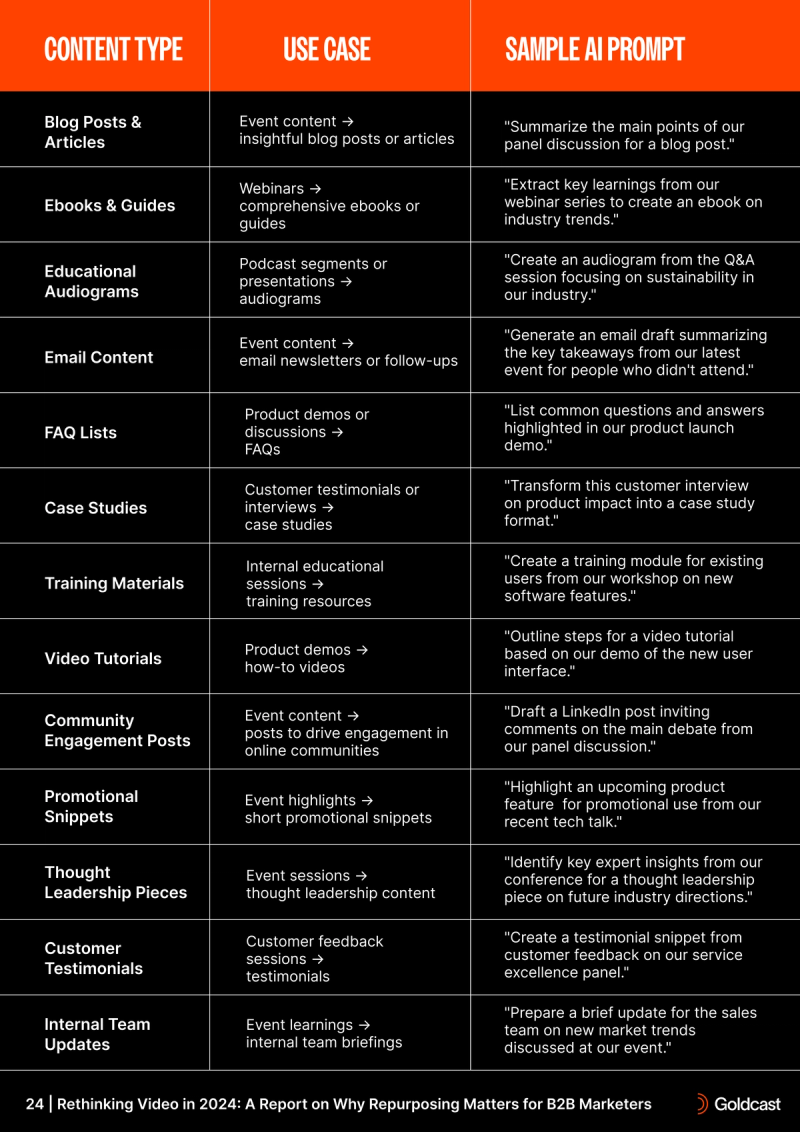
This sample list of AI prompting use cases and sample prompts shows you how versatile Goldcast Content Lab is. No matter what type of content you're trying to produce from your existing videos, it's never been easier to make it happen.
Being specific and clear with the guidance you offer the AI tool will give you a baseline to work with; if you don't get quite what you want the first time, you can iterate from there until you do.
Best practices for prompting Goldcast Content Lab
Like any AI tool, Content Lab benefits from clear, specific prompts. Here are some tips to keep in mind as you're experimenting to see what works best for you:
1. Be as specific as possible
Provide as much pertinent information as you can. AI models do best with guidance and as much context as needed to produce the result you want.
That means that when you're crafting your prompt, include as many (relevant!) specifics as you can think of. Tell AI how long you want the output to be. Explain what tone you want it to use. Give it an example if you can.
To illustrate why this matters, think about what type of blog post you might write if someone told you to create a blog about their company. Sure, you might hit the mark, but what if you come up with a 500-word blog post about the company's origin and they were actually looking for a longform blog about the company mission?
This is why we need to be specific. When marketers work with writers, they typically provide a brief with all the information the writer will need. Think of your prompt as your AI brief!
2. Use clear, concise language
Use clear, accessible language so that you don't accidentally confuse the AI tool. Using words that are commonly interpreted in different ways can open the door to miscommunication, and that's not what you want.
Focus on what really matters and be sure that your prompt is as concise as it can be, while still including the specifics you need the tool to know. You don't want to include extraneous information, as this can misdirect AI and derail your end product.
3. Incorporate SEO keywords
If you have a current SEO strategy, feel free to tell the AI tool which keywords you want to use in your content. It will work the keywords throughout your final product automatically! Then, you can use your repurposed content to boost visibility online and hopefully improve your search rankings.
4. Specify the format you want
Whether you're looking for text summaries, blog posts, social media posts, emails, or something else, tell the AI tool exactly what you want it to produce.
5. Tailor prompts to your industry
Content Lab's models can be customized for specific industries. We recommend using terminology and references unique to your industry for more tailored outputs.
Sample prompts based on these tips
Now let's see these recommendations in action! Below are two sample prompts that meet the above criteria.
Sample prompt #1: Create a 750-word blog post summarizing the key takeaways from our event session, and include at least two quotes from our company COO, Kishore Kothandaraman. Include the keywords "event repurposing" and "AI tools" at least twice. Use a professional yet engaging tone, and use this blog post as an example: [here, you would paste the link or copy and paste the text, if your AI tool doesn't accept links].
Why this works: It's specific, it's easy to understand, we've told the AI tool what keywords to focus on and what type of asset we want to create, and it's specific to our business. Sample prompt #2: Create a technical whitepaper outline from this conference recording, using industry-specific terms such as B2B marketing, event programming, and repurposed content.
Why this works: This one is industry-specific and helps Content Lab harness its industry-specific knowledge to get you even more high-impact results!
By following these best practices and using the sample prompts as a guide, you can effectively communicate with Goldcast Content Lab’s AI to create diverse and engaging content from your video recordings!
Unleash the repurposing power of AI
We've covered a lot of ground here, so let's do a quick recap!
First, we learned that audiences absolutely love video, and we discussed some of the historical challenges that kept B2B marketers from creating them. Then, we dove into why video is a non-negotiable for a successful marketing strategy these days and how AI has revolutionized video repurposing.
You learned video repurposing best practices, how to post on each social media platform, and how to find the right tool. You even got a handy checklist you can use for each event to make sure you're getting the most out of your repurposed content! And you saw how powerful prompts are when it comes to getting the content you're looking for with AI.
Ready to uplevel your content creation process now? You're invited to start your 14-day free trial of Goldcast Content Lab! Upload up to five hours of video and watch the platform churn out up to 100 free clips in just minutes.
Don't just shelve your B2B videos; turn them into powerful snippets and other assets you can use to fuel your content strategy for months to come. Start your Content Lab trial today!

Stay In Touch
Platform
Resources
© 2025 Copyright Goldcast, Inc. All rights reserved.





 Upcoming Events
Upcoming Events Event Series
Event Series On-Demand Events
On-Demand Events


